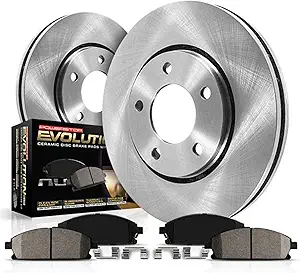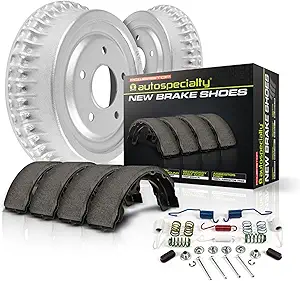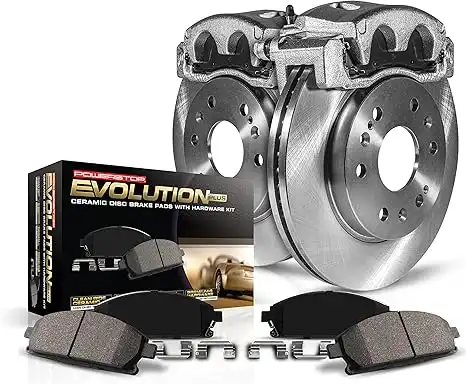Nobody gives a damn about brakes—until they don’t work.
So, can you change your brake pads? Hell yes. No fancy shop needed, no magic tools—just a jack, a wrench, and about an hour of your time.
I’ve turned wrenches for 17 years, and here’s what pisses me off: People treat brakes like an afterthought. You’ll ignore them for months, then panic when the car sounds like a dying robot. Newsflash—grinding means you’re already screwing up your rotors.
But here’s the good part: You don’t need to be some certified pro. If you can change a tire, you can do this. I don’t care if you’re in some tiny garage in Manchester or sweating in a Houston driveway—this ain’t rocket science. Follow these steps, and you’ll stop faster without getting ripped off.
Table of Contents
🚦 Before You Begin: Why Your Brake Pads Matter More Than You Think
You might think of brakes as something you “deal with later”—until later becomes too late. Here’s the deal:
Brake pads wear down gradually, which means many people don’t notice how badly their stopping distance has increased until it becomes dangerous.
Replacing brake pads on time can:
- Keep your rotors from getting ruined ($$$)
- Help you stop faster in emergencies
- Improve fuel efficiency (yes, really)
- Keep your passengers and pedestrians safe
🛠️ Pro Insight: I’ve worked on cars that could barely stop at red lights—all because the owner delayed a simple brake pad swap. Don’t let that be you. If your pads are under 3mm thick, it’s time.
Let’s get into the systems first, so you know what kind of brakes you’re working with.
🛠️ Know Your Brakes: What Kind of System Does Your Car Use?
Listen up, gearheads and first-timers – here’s how brakes really work in the real world, no textbook fluff.
1️⃣ Disc Brakes – What You’re Probably Working On

See that shiny silver dinner plate behind your wheel? That’s your rotor.
- How they work: Caliper squeezes two pads onto spinning rotor
- Why I like ’em: Dead simple to fix – great first DIY job
- Watch your ass: Slide pins seize up, especially in rust belt states
- Pro move: Always replace pads in axle sets (both fronts or both rears)
2️⃣ Drum Brakes – The Spring-Loaded Nightmare

Common on cheap cars and old trucks – total pain in my…
- What’s inside: Shoes, springs, and frustration
- Why they suck: One wrong move and springs go flying
- Mechanic’s trick: Use needle-nose vise grips to hold springs
- When to walk away: If everything’s rusted solid, just buy the whole assembly
3️⃣ Hybrid/EV Brakes – Different Animal
These pads last forever… until they don’t.
- Secret sauce: Regen braking does most the work
- Gotcha: Rotors rust out before pads wear down
- Weird quirk: Some need a damn computer to retract pistons
- My advice: Let the dealer do it if you’re not tooled up
👀 Spotting Your Brake Type
No need to guess – here’s how to tell:
- Discs: See the rotor? Duh, disc brakes
- Drums: Looks like a sealed metal bowl
- Don’t be that guy: Check all four wheels – mixes happen
🌨️ Weather Woes
Salt belt? You’re screwed:
- Northeast/Midwest cars: Assume everything’s rusted
- Coastal areas: Corrosion central
- Survival tip: PB Blaster is your best friend
💸 Part Buying Smarts
Don’t get hosed at the parts store:
- Always give your VIN – brake specs vary wildly
- Cheap pads = noise and dust
- Reman calipers? Just buy new
Final word: Brakes ain’t rocket science, but screw this up and you’re in a world of hurt. When in doubt, ask an old timer at your local parts store – they’ve seen it all.
🔧 Changing Brake Pads – The Right Way (From a 17-Year Mechanic)
Listen up – I’ve seen too many DIY brake jobs go sideways because people skip steps. Here’s how to do it properly without killing yourself or ruining your brakes.

⚙️ The REAL Tools You Need (No BS)
- A proper jack (not that flimsy emergency one in your trunk)
- 2 jack stands (because your life is worth $40)
- Breaker bar (for those rusted-on lug nuts)
- 14mm-17mm sockets (caliper bolts vary by make)
- C-clamp (the big one from your dad’s toolbox)
- Brake lube (the copper kind – don’t cheap out)
- New pads (get ceramic if you hate brake dust)
- Wire coat hanger (the universal mechanic’s tool)
🛠️ Step-by-Step (Like I’m Standing Next to You)
- Park Smart
- Level ground only
- Wheel chocks behind the opposite tires
- Parking brake FIRMLY engaged
- Break Lug Nuts Loose First
- Do this while the wheel’s on the ground
- Leftie loosey (except on some German cars)
- Lift It Right
- Jack under the pinch weld (not the oil pan!)
- Jack stands under frame points
- Give the car a solid shake test
- Get Naked (The Wheel)
- Remove all lugs completely
- Set wheel flat so it doesn’t roll away
- Caliper Surgery
- Find the two slider bolts (usually 14mm)
- Crack them loose with a cheater bar if needed
- Hang the caliper with your hanger – NOT by the hose!
- Out With The Old
- Note how the old pads sit before removing
- Compare thickness to new pads (should be night and day)
- Piston Push-Back
- Use the C-clamp and an old pad to press it in
- If it won’t budge, you might need to open the bleeder
- (Rear brakes? Might need the twist-and-push method)
- Lube Job
- Copper anti-seize on pad backing plates
- Silicone grease on slider pins
- Wipe off any excess – this isn’t mayo
- New Pads In
- Clip them in exactly like the old ones came out
- Listen for the “click” of proper seating
- Reassembly
- Bolt the caliper back on (snug, then 1/4 turn)
- Hand-start all lug nuts before lowering
- Pedal Pump
- 5-6 firm pumps until resistance builds
- Start engine and pump a few more times
- Test Drive Protocol
- First stop: 10mph in your driveway
- Then 25mph with gentle stops
- Listen for scraping or uneven grab
🚨 Red Flags (When to Abort Mission)
- Piston won’t compress (stuck caliper)
- Rotor has deep grooves (needs replacement)
- Brake fluid leaks (bigger problems)
- Pedal goes to floor (air in system)
💯 Why This Works
I’ve done this exact sequence on:
- Rusted-out Canadian winter beaters
- Texas trucks with 200k miles
- Euro cars with “special” brake systems
…and lived to tell about it.
The trick? Take your time, don’t skip steps, and for God’s sake use good parts. Your brakes are the only thing between you and that minivan full of kids.
🚦 When Your Brake Pads Are Screaming for Help
Forget mileage estimates – your brakes tell you when they’re dying. Here’s what to listen for:
🚨 Emergency Replace Now Signs:
- Metal-on-metal GRRRRIND (you’re already screwed)
- Pedal sinks to the floor (dangerous fluid leak)
- Car pulls hard left/right (stuck caliper)
⚠️ Schedule Replacement Soon:
- High-pitched screech (wear indicators)
- Shaky steering wheel when stopping
- Pads thinner than a credit card (3mm)
📍 Winter Drivers Note:
Salt + slush = brake rotors rusting faster. Check pads:
- Before first snowfall
- After brutal ice storms
- When washing undercarriage
🚗 Brake Pad Replacement FAQs
Got questions? I’ve got answers – no fluff, just straight-shooting brake advice you can trust.
1. “Can I change my own brake pads?”
Hell yes you can.
- Needs: Basic tools + 1-2 hours
- Saves: $150-$300 per axle vs. shops
2. “How hard is a brake pad job?”
Easier than parallel parking if:
✔ You’ve changed a tire before
✔ Your bolts aren’t rusted solid
✖ Avoid if: You can’t tell a wrench from a screwdriver
3. “When do brake pads need replacing?”
Act fast if you hear:
- High-pitched screeech (warning tabs)
- Metal grrrrind (you’re damaging rotors)
- See less than 3mm pad (thickness of a nickel)
4. “What tools do I absolutely need?”
Non-negotiables:
- Jack + stands ($50 at Harbor Freight)
- C-clamp (to squish piston back)
- Brake grease ($5 tube lasts years)
- Breaker bar (for stubborn bolts)
5. “Do I need to bleed the brakes?”
Only if:
- Brake fluid leaks
- Pedal feels mushy
- You’re replacing calipers
Otherwise? Leave the bleeder valve alone.
6. “Where exactly do I grease?”
Grease these spots ONLY:
✓ Back of brake pads
✓ Caliper slide pins
✓ Any metal-to-metal contact points
Never: Rotor surface or pad friction material
7. “Can I spray WD-40 on squeaky brakes?”
F*CK NO!
- WD-40 = less stopping power
- Will stink when hot
- Could cause complete brake failure
8. “What’s the best brake lube?”
Mechanic’s choice:
- Permatex Ceramic Lube (quietest)
- CRC Brake Quiet (stickiest)
- Copper Anti-Seize (best for rust)
9. “Will Q20 work as brake lube?”
Not even close.
Can eat rubber seals over time
Q20 burns off at high temps
Attracts dirt and dust
🔧 Final Word: Stop Paying Shops for This
Most brake jobs are 80% labor markup. Now? You’ve got the knowledge to:
✔ Save $200+ per axle
✔ Avoid getting scammed (“Oh, your rotors are shot too!”)
✔ Know your car won’t kill you
Your Next Moves:
- Test your skills: Try one wheel first
- Invest the savings: Buy quality tools
- Spread the knowledge: Tag a friend who overpays for brakes
Got stuck? My DMs are open – no stupid questions when it comes to brakes.
“But what if I—”
No. Just go do it. Your wallet will thank you.
[📌 Save this guide] | [🔧 More DIY fixes] | [💬 Horror stories welcome]

Pingback: Car Shakes When Braking? Fix Your Brakes Like a Pro
Pingback: 8 Car Dash Symbols: Meanings, Fixes & Expert Tips